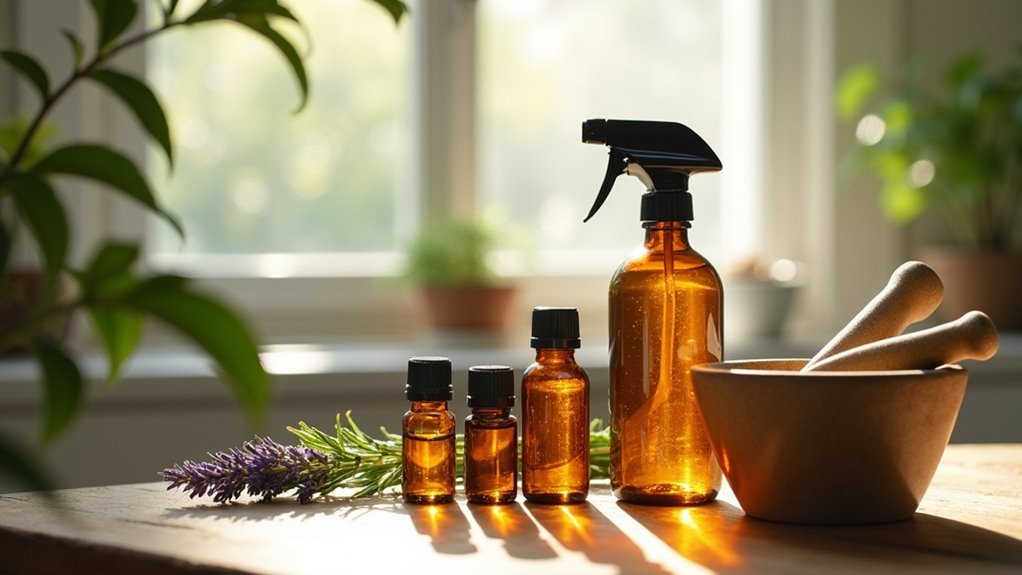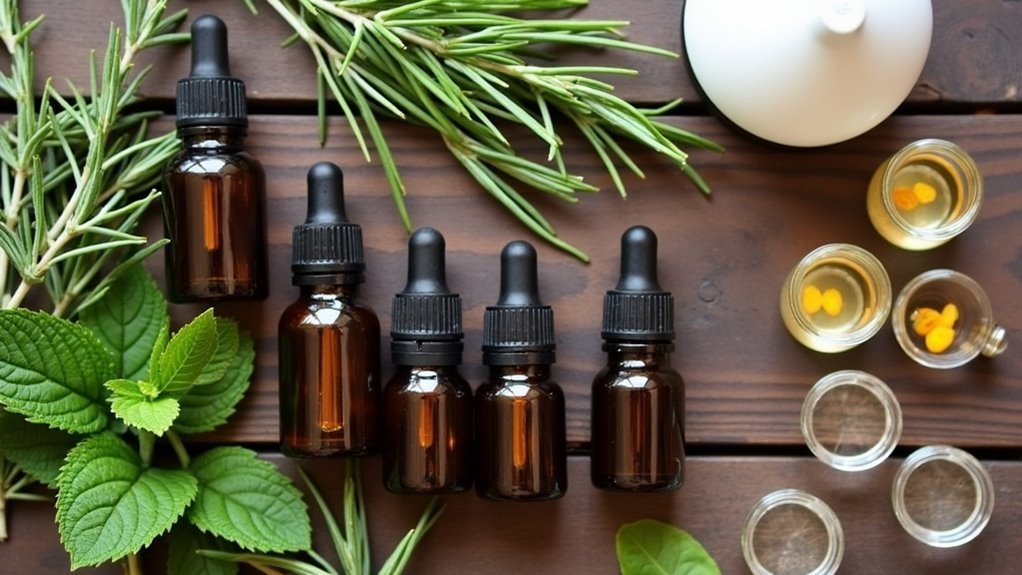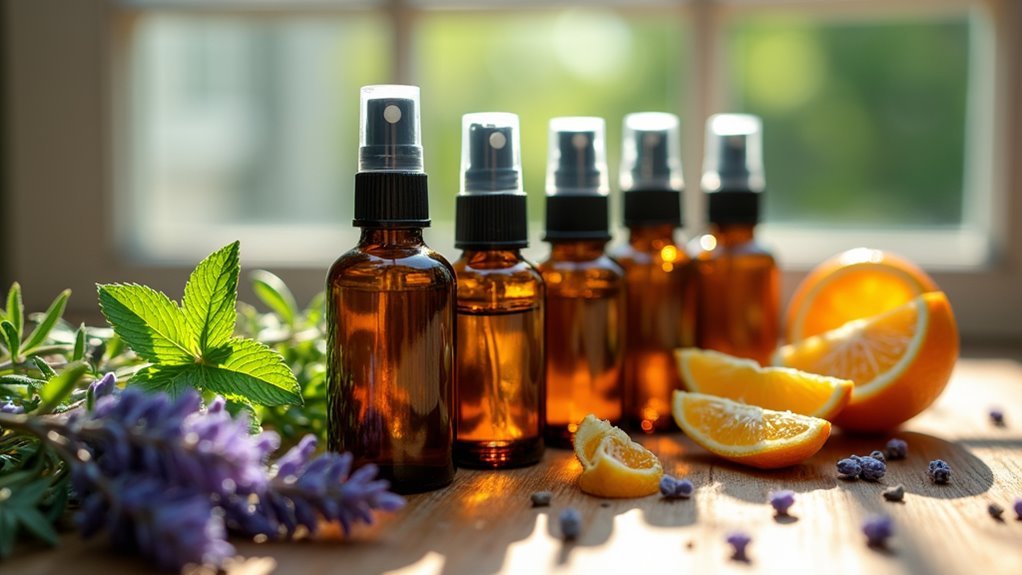You can create an effective DIY essential oil pest prevention routine by mixing 10-20 drops of peppermint, eucalyptus, or citronella oils with 2 cups of water in a spray bottle. Add 5 drops of dish soap for better adherence, then apply around entry points and problem areas every 3-5 days. Focus on specific oils for targeted pests: peppermint for ants and spiders, eucalyptus for cockroaches, and citronella for mosquitoes. This all-encompassing approach will transform your home into a naturally protected environment.
Understanding Essential Oils for Natural Pest Control

The concentrated plant extracts known as essential oils offer a powerful, natural alternative to synthetic pesticides for protecting your home and garden.
These potent substances contain compounds that naturally repel insects and pests without harming your family or the environment. Essential oils provide effective results against common pests like ants, spiders, and mosquitoes through their strong aromatic properties.
You’ll find that peppermint oil works exceptionally well against ants and spiders, while eucalyptus and citronella target mosquitoes effectively.
To implement natural pest control, you can create a spray by mixing your chosen essential oil with water and a carrier oil. This eco-friendly pest control method serves as an excellent pest repellent that’s both safe and sustainable for regular use.
Best Essential Oils for Common Household Pests
When dealing with specific household pests, certain essential oils prove more effective than others based on their unique chemical compositions and aromatic properties.
The best essential oils for cockroaches include eucalyptus and tea tree, which work as natural solutions in kitchens and living areas.
For ants, spearmint, peppermint, and lemon oils create effective pest control methods that repel pests from food prep spaces.
You’ll find rosemary, peppermint, eucalyptus, and basil oils particularly useful against flies.
Mosquitoes respond well to peppermint oils, citronella, lemongrass, and tea tree combinations that are effective against mosquitoes. A few drops of tea tree oil help keep them at bay.
Essential oils for pest management also include spearmint and peppermint for spiders, applied along entry points.
Creating Your Essential Oil Pest Prevention Toolkit

You’ll need to assemble a thorough toolkit that includes the right essential oils, proper application tools, and safe storage solutions to effectively combat household pests.
Your success depends on selecting proven pest-repelling oils like peppermint and citronella, choosing appropriate delivery methods such as sprays or diffusers, and maintaining proper storage conditions to preserve potency.
Let’s examine each component to build your most effective essential oil pest prevention arsenal.
Essential Oil Selection
Building an effective essential oil pest prevention toolkit starts with selecting oils that target specific unwanted visitors in your home and garden.
Your essential oil selection should focus on proven natural insect repellent properties that address different pest challenges.
Consider these core oils for thorough pest prevention:
- Peppermint – Effectively repels ants and spiders with its strong menthol scent
- Lavender oil – Naturally deters moths and fleas while providing pleasant aromatherapy benefits
- Eucalyptus – Powerful against mosquitoes and ticks for outdoor protection
You’ll also want citronella for outdoor mosquito control and tea tree oil for its antibacterial properties against various pests.
Purchase essential oils directly from reputable manufacturers to guarantee purity and effectiveness.
Avoid products with harmful additives that can compromise your natural pest prevention routine’s safety and potency.
Application Method Options
Once you’ve assembled your pest-fighting oils, the next step involves choosing the right application methods to maximize their effectiveness throughout your home and garden.
Essential oils offer versatile deployment options that suit any environmentally conscious homeowner’s needs.
Create targeted spray solutions by combining oils like peppermint, eucalyptus, and tea tree with water in a spray bottle. Shake well before each application to guarantee proper mixing.
For concentrated treatment, soak cotton balls in these potent oils and place them strategically in problem areas.
Enhance your regular cleaning solutions by adding several drops of lavender or tea tree oil, creating dual-purpose formulas that clean and repel pests simultaneously.
You can also apply these oils through diffusers, establishing aromatic barriers throughout living spaces while maintaining pleasant indoor environments.
Storage and Safety
Proper storage and handling practices determine whether your essential oil pest prevention arsenal remains potent and safe for long-term use.
You’ll want to store your oils in dark glass bottles within cool, dry locations to protect their effectiveness from light and heat degradation.
Essential safety measures include:
- Label everything – Write the oil name and purchase date on each container to track freshness
- Keep away from children and pets – Store oils in secure locations since some varieties can be toxic if ingested
- Use carrier oil for topical applications – Mix with coconut or jojoba oil to prevent skin irritation
Regular inspection of your storage area helps maintain potency.
Check for changes in scent or appearance that indicate spoilage, ensuring your pest prevention toolkit remains both effective and safe.
Step-by-Step Guide to Making DIY Pest Deterrent Sprays

Creating your own pest deterrent spray requires just a few simple ingredients and takes less than five minutes from start to finish.
Start by gathering your spray bottle and choosing potent essential oils like peppermint, eucalyptus, or lavender. Add 10-20 drops of your selected oils to 2 cups of water or vinegar in the spray bottle.
Mix 10-20 drops of peppermint, eucalyptus, or lavender essential oils with 2 cups of water or vinegar in your spray bottle.
Don’t forget 5 drops of dish soap—this vital ingredient helps emulsify the oils and makes your DIY pest deterrent stick to surfaces effectively.
Shake well before every application to guarantee proper blending. Apply liberally around entry points, food prep areas, and problem spots during early morning or evening hours. This timing prevents potential foliage damage while keeping pests at bay.
Remember to refresh regularly, especially after rain or cleaning, and store unused mixture in cool, dark locations.
Application Methods for Maximum Effectiveness
While making an effective essential oil spray is straightforward, applying it strategically determines whether you’ll achieve lasting pest control or waste your efforts.
Target specific areas where pests typically enter or congregate in your home. For roaches, spray oil solutions directly into cracks and behind appliances. Place oil-soaked cotton balls in infested spots for continuous repellent action. Ants require barrier treatment around food preparation areas using your natural spearmint mixture.
- Reapply essential oils every 3-5 days since natural compounds evaporate faster than chemical alternatives.
- Focus on entry points like windowsills, doorframes, and gaps where pests infiltrate your home.
- Combine spray applications with oil-soaked materials for prolonged effectiveness against stubborn infestations.
Always test spray solutions on small areas first to guarantee they won’t damage surfaces while maintaining maximum repel power.
Establishing a Weekly Pest Prevention Schedule
Sporadic applications won’t deliver the consistent protection your home needs against persistent pests. Establishing a weekly pest prevention routine with essential oils guarantees you’re always one step ahead of unwanted invaders.
Start by dedicating specific days for different areas. Mix 12 oz water with 15 drops of peppermint oil weekly to spray around outdoor spaces—this effectively repels mosquitoes and other pests.
Choose another day for indoor treatment, combining 3 oz water with 10 drops of eucalyptus oil to prevent cockroaches.
Your monthly deep clean should include pet areas using lavender oil solutions, while bi-weekly garden applications target various outdoor pests.
Apply all essential oil treatments during early morning or late evening hours for maximum effectiveness without harming plants.
Protecting Pets and Children While Using Essential Oils
How can you keep your family and furry friends safe while implementing an effective essential oil pest prevention routine? You’ll need to take specific precautions when using essential oils around children and pets.
Always consult your veterinarian before introducing any drops of essential oil into your home, as certain oils can be toxic if inhaled or ingested.
Before using any essential oils for pest control, always get your veterinarian’s approval to ensure your pets’ safety.
Essential safety measures include:
- Verify oils are diluted appropriately with carrier oils or water to prevent skin irritation
- Use essential oils only in well-ventilated areas and keep diffusers away from pets and children
- Monitor pets closely for adverse reactions like breathing difficulties or skin irritation
Unlike harsh chemicals, essential oils can create a safe environment for pest control when used responsibly.
Discontinue use immediately if any symptoms develop.
Maintaining Your Essential Oil Pest Control System
Your essential oil pest control system requires consistent maintenance to remain effective against unwanted invaders.
You’ll need to understand proper storage techniques and shelf life expectations to maximize your oils’ potency over time.
Following the right reapplication schedule guarantees continuous protection while preventing pests from adapting to your natural deterrents.
Storage and Shelf Life
While essential oils offer powerful pest-fighting properties, they’ll lose their effectiveness if you don’t store them properly. To keep essential oils potent for maximum pest control, follow these storage guidelines:
- Protect them from light by using dark glass bottles and storing in a cool dry place away from windows.
- Track freshness with labels showing purchase dates – most essential oils have a shelf life of 1-3 years, while citrus varieties last only 6 months to 1 year.
- Maintain quality of diluted solutions by using within weeks and storing in cool areas.
High-quality essential oils require proper storage to preserve their pest-fighting compounds.
Heat and humidity will degrade their potency, so avoid bathrooms or sunny locations.
Always shake diluted solutions before each application to guarantee proper mixing.
Reapplication Frequency Guidelines
Even with proper storage, essential oils require consistent reapplication to maintain their pest-deterrent power.
You’ll need to reapply your essential oil pest control solutions every 7-14 days outdoors, particularly after rain or heavy moisture that can dilute the oils.
For indoor applications, revitalizing every 4-6 weeks prevents pests from becoming accustomed to the scent.
Monitor pest activity regularly and adjust your frequency based on observed infestations.
During peak pest seasons, you’ll want to increase applications accordingly.
When using garden sprays, reapply after significant plant growth or trimming to guarantee adequate coverage remains effective.
Store your essential oil mixtures in cool, dark places and always shake before use to maintain potency for maximum performance during applications.
Frequently Asked Questions
How Do You Make Essential Oils for Pest Control?
You’ll combine 12 oz water with 15-20 drops of peppermint, eucalyptus, or citronella oils. Add dish soap drops for emulsification, shake well before use, and spray during early morning or evening.
How to Use Essential Oils to Deter Insects?
You’ll spray essential oil mixtures on surfaces where insects gather. Mix 10-15 drops per cup of water, then apply weekly to entry points, outdoor areas, and pet coats for effective deterrence.
What Essential Oil Is Best for Pest Control?
You’ll find peppermint oil’s the most versatile choice for pest control. It effectively repels ants, spiders, mosquitoes, and flies with its strong aroma and natural insecticidal properties, making it ideal for extensive indoor pest management.
How Do You Dilute Essential Oils for Insect Repellent?
You’ll combine 10-15 drops of essential oil with 2 cups of water and 1 tablespoon of carrier oil in a spray bottle. Always shake before using and test on skin first.
In Summary
You’ve now got everything you need to create an effective, natural pest control system using essential oils. Start implementing your weekly routine today, and you’ll notice fewer unwanted visitors in your home. Remember to rotate your oil blends, monitor their effectiveness, and always prioritize safety around pets and children. With consistent application and proper maintenance, you’ll keep pests at bay without harsh chemicals. Your natural pest prevention system is ready to work.





Leave a Reply